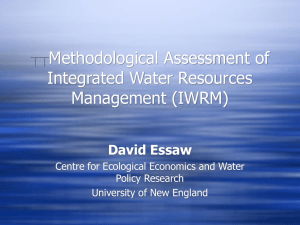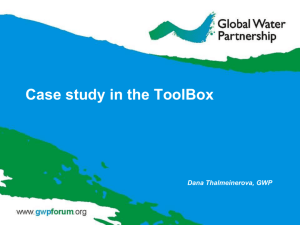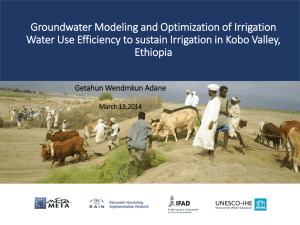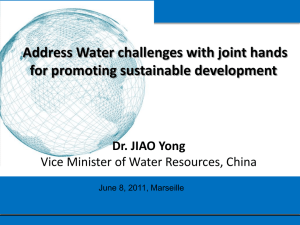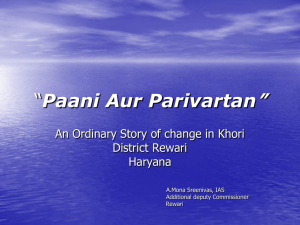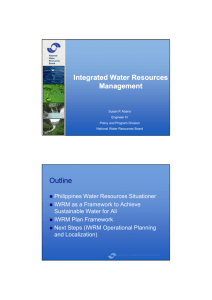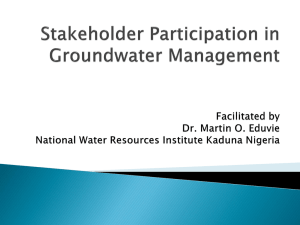Water resources Management based on IWRM principles
advertisement
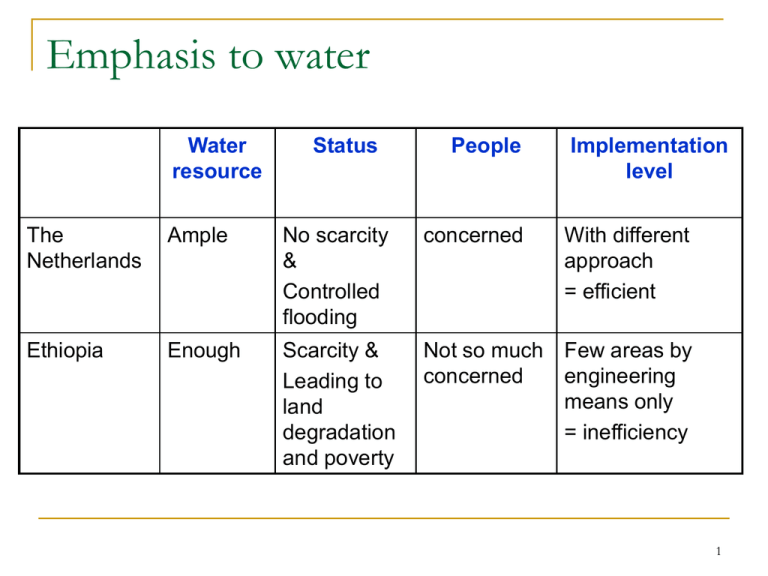
Emphasis to water Water resource Status People Implementation level The Netherlands Ample No scarcity & Controlled flooding concerned With different approach = efficient Ethiopia Enough Scarcity & Leading to land degradation and poverty Not so much Few areas by concerned engineering means only = inefficiency 1 Some of manuscripts Chain of water uses 1. Crop production 2. Ecology 3. Domestic water supply 4. Irrigation 5. Hydropower 6. Fishery 7. Transportation 8. Industry 9. Tourism, … 4 3 2 1 5 6 Works 1. in all towns 2. in all villages 3. in all micro-watersheds 4. in the whole highlands of Ethiopia IWRM and MUS in Ethiopia Rainwater management based on IWRM principles: for chain of water uses House-hold and community experience in Amhara region, Ethiopia. November 22, 2010 By Mastewal E. Ademe IFAD – PASIDP Coordinator BoA Titles 1. 2. 3. 4. 5. Introduction Objective Materials and Methods Results and Discussions Conclusion and recommendation 4 1. Introduction IWRM which promotes the coordinated development and management of water, land and related resources, is accepted as a guiding principle for attaining water use equity, economic efficiency and environmental sustainability of a watershed area. Interrelated nature of different: Sources, Impacts, and Uses of water is a major driving force to the introduction of IWRM process. 5 In line with this Ethiopian water resources management policy (MoWR, 1999) based itself on the core values of IWRM. Nevertheless, circumstances on ground to manage water resources are not full-fledged in the country particularly to Amhara region. 6 Associated problems - land erosion, degradation, flooding - sedimentation to the lake & reservoirs - low/no groundwater/baseflow during dry period for water supply/irrigation Silted up Adrako Micro-earth irrigation dam 7 Rib river brought a lot of biomass, Women and Children were collecting Wood materials, Date: Friday 15-06-07 Date: Tuesday 19-06-07 Rib irrigation dam is under construction Flooding treat to Lake Tana Basin In the region rainwater, which is the major water resource, having the highest water value is not managed explicitly for ecological and social development, in well-organized and sustainable manner. Despite its tremendous water potential and value, water scarcity, poverty and land degradation in the region remains rampant. Water resources overview Generally, Ethiopia has adequate average annual rainfall in most areas, several major rivers and lakes, and significant groundwater resources. Surface water resources are estimated at 122 billion cubic meters per year (12 major river basins and 22 lakes). Renewable groundwater resources are estimated to be about 2.6 billion cubic meters (MoWR, 2002a). Although less than 2 percent of these resources are diverted for use, the current estimated per capita renewable freshwater resources of 1,900 cubic meters (MoWR, 2002b) indicates an abundance of water. The Amhara National Regional State has 29 % of the country’s annual surface water potentials and 20 % of the potentially irrigable land of the country (3.5 million hectares). Four river basins are found in the region namely Abay, Tekeze, Awash and Afar-danakil river drainage basins. Those rivers have huge potentials for crop production, ecology, domestic water supply, irrigation, hydropower, fishery, transportation, industry, tourism, … However, these huge potentials of water resources are under developed (BoFED, 2006; MoWR, 1998). 10 Table 1: The water resources of basins that the region has major shares (ESP, 2003) River basin Catchment area (km2) Abbay (46 %) 199,812 52.6 1.23 Tekeze (30 %) 89,000 7.63 0.18 Awash (18 %) 112,700 4.6 0.13 Danakil (6 %) 74,00 0.86 0 475,512 65.69 1.54 Total Annual Ground water Runoff (bm3) (bm3) a huge gap between annual runoff with the remaining ground water reserve. That is probably due to lack of proper rainwater management activities based on IWRM principles on most part of the region. In addition, there are significant evaporation losses that require similar treatment. 11 Fig. 1: General overview of rainfall partitioning in farming systems in the semi-arid tropics of sub-Saharan Africa. (Source: Rockstrom et al., 2003). 12 2. Objective The objective of the study was to evaluate farmers practice on rainwater management based on IWRM principles satisfying: ecology, economic efficiency and equity of water use. following source to end user from increased chain of water use. 13 3. Materials and Methods Reference books, Video camera, Semi structured questioner, This study was carried out together with experts from different discipline, administrative leaders and the study team in respective Kebeles, districts and Zones where the study was conducted. at regional level 5 experts, at Zonal level 7 experts, at district level 16 experts and at Kebele level 20 community members were participated beside two development agents in each Kebele, totally 362 persons were participated. Out of them 240 are farmers. Direct observation, interviews and discussions were employed, The study was conducted in 3 Zones of Amhara region and 2 Woreda in each Zone totally 6 Woreda were investigated of use of IWRM principles. 2 Kebeles in each Woreda were selected one potential and one least potential Kebele. Totally 12 Kebeles were investigated. 14 4. Results and discussions From the observed 240 farming-community members about 20 % of the farmers have adequate knowledge to implement rainwater management with IWRM principles. 9 % of the community members are at implementation 11 % at concept level they show at least the watershed area where water drains out. 91 % of the farmers do not integrate their limited resources and activities to manage the rainwater resource. This significantly correlates with the current major problem of the region i.e. water scarcity, land degradation, sedimentation, flooding and poverty. Household and Community Experiences Those practices were commencing under the assistance of multi-disciplinary experts from BoA and NGOs acting at different times basically to: reduce sedimentation to Angereb Water supply Dam (household) increase groundwater reserve (community). Opportunity:- awareness, training, and technical support. 15 At house-hold level The area is situated within Angereb dam watershed in Tana sub basin; this particular area is located on steep mountainous part. From all observations this house hold in Lay-Armachiho district Chirakedisty Kebele is at best experience level to achieve optimized rain-water use. This approach is integrated within their micro-watershed area As upland is treated with appropriate soil and water conservation measures to recharge groundwater. It allows resources to recycle with in it, and At the outlet of the micro-watershed, wells are used for Irrigation and Domestic water supply. Also close follow up and maintenance got higher attention by the family members for increased chain of rain-water use. 16 Watershed Development for High crop yield, wood, compost, bee having, … Irrigation Development Environment Water supply Development 17 This practice took: 6 years for irrigation and 7 years for water-supply to get ground water. In their small watershed their limited farm-resources and activities are integrated to manage the rain-water resource basically by reducing runoff and evaporation losses. Rockstorm et. al. (2003) confirmed that evaporation can be transformed into useful transpiration, thus contributing to increased water productivity including augmentation of ground water. The house-hold leader that was interviewed by the group said that all community members should contribute for rain-water management for coordinated development of the watershed. For this important initiation they have an agreement to cooperate similar interventions in their Kebele to watershed management. He and his wife are also capable to discuss IWRM principles properly from their experiences. That can be used for experience sharing to other community members. 18 At community level From communities where assessment was made Kobo district Shewoch-Mariam Kebele is found to be the best. Here the major types of watershed activities implemented include terracing, water way, agro-forestry, green manure, mulching using crop residues, composting, water supply and irrigation. close follow up and maintenance got higher attention by the implementers. This was on an area where there was critical drinking water scarcity before 4 years. But now they achieved water surplus for drinking and beyond that for irrigation. 19 Stone-faced soil bund Rehabilitated watershed 9% Increased soil moisture Check-dams 4 years hard work for Getting spring after 17 yrs 11 % 20 Rehabilitated watershed good rain-fed farming Increases the chain of water uses Cloth washing/Sanitation Water supply Cattle trough Irrigation with the excess water & groundwater Cattle feed, Ecology and Downstream water users Imagine also the reverse 21 In both cases the result of watershed developments for irrigation and water supply based on IWRM principles at family and community level shows significant groundwater reserve for later use during dry periods. Moreover, both practices also have important returns for down stream water-users, which further optimizing water use. To observe more advantages of these experiences it is good to look it at different angles. Advantages from: Community Household Women’s Children points views Downstream MDGs and for the world. 22 Community point of view include; soil erosion is reduced, down stream sedimentation is minimized, it reduces non-point pollution sources, physical scarcity of water is minimized for local people, local micro-climate is improved, flooding is controlled and groundwater is recharged for down stream communal irrigation schemes i.e. improved hydrologic cycle benefiting local people for increased chain of water use. 23 House hold level; They achieved high income from different farm product sells (crop, honey, livestock, hen, irrigated grass and vegetables…). They are able to get hand-pump for irrigation purpose in the form of prize i.e. they are recognized, soil loss is minimized, the land is covered with flowering vegetations (good for their beehaving activities), local micro-climate is improved, improved hydrological cycle (water is stored for latter use in this case environment, irrigation and water supply near by their house), soil fertility enhancement from put into operation of agro-forestry (N2fixing plants), green-manure and compost. From other perspective applied compost increases soil water holding capacity and increases infiltration additional benefit compared to use of chemical fertilizers (also reduces expenses). Other farm activities are taking place integrated in their small watershed; creating good state of bio-interaction in the area. 24 Women’s point of view include; they will not travel long distance to fetch water hence reduced work burden and risks on women, collect fire wood and wash clothes nearby the house. Hence with the house hold members can spend spare time (morning and evening) to follow up their watershed activities. Children point of view include: they put on neat cloth i.e. improved sanitation and hygiene for good health condition, get more follow up and advice from their parent, school expenses will be covered from vegetable sales from irrigation, they will be involved in practical knowledge of IWRM, and they will get opportunity to implement what they learned from school. Downstream point of view: Sustains groundwater and base flow for equity - value addition Improves the local micro-climate from increased vegetation MDGs and for the World: Achieving sustainable development is the key to meeting the MDGs Significant carbon assimilation is also possible (integrated approach). 25 Those approaches are sustainably integrated because both satisfy IWRM principles. Because they understood, water is finite and vulnerable and acted accordingly. participation to local rainwater management for access to water of adequate quantity and quality for the sustenance of human well-being. women interest is on highest agenda. social and economic cost of water is highly recognized since water is used with optimum possible efficiency. Beside from the three “E” point of view they use their share of rainwater column i.e. low competition on other water sources fulfilling equity criteria from the society share, they assured evergreen land cover with improved microclimate satisfying environmental integrity for next generation too, they get additional benefits from ground water reserve use achieving optimum economic efficiency. Climatic change mitigation Improved micro-climate helps to mitigate climatic change effects from improved rainwater management 26 a lot of activities undertaken as in the form of soil and water conservation and forestation program but not yet in an integrated approach Overall lack of means to store water in times of plenty place the farming community at risk of drought and chronic food shortages. In addition massive efforts of dams, diversions, ponds, soil and water conservation activities are not yet in place through in many watersheds, To meet the ever increasing water demand (food production/water supply) every peace of land should be treated with IWRM principles to achieve increased chain of water uses. The major problem is the approach to increase rainwater productivity based on IWRM principles are not clearly known to the majority of the farming-community. the majority of higher experts (Yonas and Derje, 2008). runoff and soil erosion are from God. They do not believe that it is due to their day-to-day activities on land that influences the water use and loss. 27 5. Conclusion and Recommendation Recognize implementation of IWRM for increased chain of water uses is the key option to fulfill economic development and mitigate climatic change effects for highlands of Ethiopia, It also assists to have low-cost and decentralized water supply and sanitation implementation everywhere including on degraded lands, Water supplying agencies do not get easily groundwater on highlands (it is possible as long as there is enough rainfall), Hence to achieve cumulative-joint effort on the ground: continues training, experience sharing, technical support and awareness creation (supported with video films) at community level is indispensable. Beside integrated, multidisciplinary and inter-sectoral approach at all level is necessary, Guidelines for farmers with relevant trainings should be given to make them aware of the possibilities to do RWH and IWRM to meet their needs for multiple use, even if there is not enough groundwater. As a final point, to execute this enormous task at large it is significantly important to have multiple use water service guidelines with responsible IWRM advisory and training institution for the region; at large for the country. 28 Thank you!! 29
